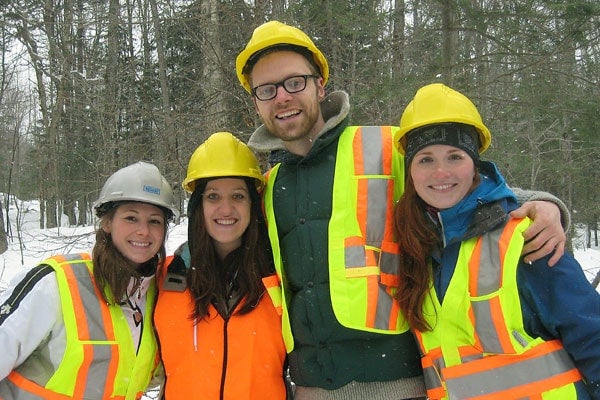
Master of Forest Conservation students learn the clear-cut truth
Published: March 14, 2012
When forestry student Jennifer Gagné got her first glimpse of a “clear cut” in a Forestry Stewardship Council-certified forest near Sparks Lake, Ont., she was shocked.
“I had this perception of what a clear cut should look like, but when we got to the site, it looked completely different,” she said. “You picture a desolate wasteland, but we saw healthy seed trees and seedlings.”
The Faculty of Forestry’s master of forest conservation (MFC) program’s annual field trip to the North Bay and Mattawa area allows students to connect what they’ve been learning in the classroom to on-the-ground forestry operations in the north.
“We’ve been learning that in some ecosystems, mass disturbances like fire and windstorms are common and are actually the primary means of regeneration for a forest. When you’re harvesting from these forests, it makes sense to emulate mass disturbances to create optimal conditions for regeneration,” said Gagné. “We saw that it can really work.”
The four-day trip was organized by the Canadian Institute of Forestry (CIF) for the 16th year, and students were housed at the Canadian Ecology Centre outside North Bay. Each morning they strapped on snowshoes and made their way into outdoor classrooms to see different sustainable silviculture systems (management techniques that enable forests to produce a harvest and remain ecologically intact). The group toured sustainably managed woodlots, a sawmill, forest industry cut blocks [areas designated for harvesting] and National Resources Canada’s Petawawa Research Forest.
“We practiced our tree marking skills, saw a red-tailed hawk’s nest and learned about all the different factors that feed into the complicated world of forest management,” Gagné said.
Ontario law states that the presence of a hawk’s nest in a designated cut block necessitates that it be given a wide buffer of untouched forest.
The experience was as much about culture as it was about science. Students were fed a traditional “lumber jack meal” in Mattawa, courtesy of the CIF, before ending the trip with an outdoor campfire and group wolf-howl that elicited a response from the dark hills that surrounded them.
Connection to the land and to one’s classmates and colleagues was one of the best benefits of the trip, said students Susan Frye and Natasha Machado.
“More than anything, the connections we were able to make with scientists and forestry professionals are so valuable – we’re being exposed to a tight-knit community that we know we are welcomed into,” said Frye.
“Our two international students made their first ever snow angels in the woods,” Machado added. “That was a great moment.”



